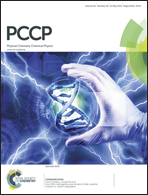Catalytic activity of Pd-doped Cu nanoparticles for hydrogenation as a single-atom-alloy catalyst
Abstract
The single atom alloy of extended surfaces is known to provide remarkably enhanced catalytic performance toward heterogeneous hydrogenation. Here we demonstrate from first principles calculations that this approach can be extended to nanostructures, such as bimetallic nanoparticles. The catalytic properties of the single-Pd-doped Cu55 nanoparticles have been systemically examined for H2 dissociation as well as H atom adsorption and diffusion, following the concept of single atom alloy. It is found that doping a single Pd atom at the edge site of the Cu55 shell can considerably reduce the activation energy of H2 dissociation, while the single Pd atom doped at the top site or in the inner layers is much less effective. The H atom adsorption on Cu55 is slightly stronger than that on the Cu(111) surface; however, a larger nanoparticle that contains 147 atoms could effectively recover the weak binding of the H atoms. We have also investigated the H atom diffusion on the 55-atom nanoparticle and found that spillover of the produced H atoms could be a feasible process due to the low diffusion barriers. Our results have demonstrated that facile H2 dissociation and weak H atom adsorption could be combined at the nanoscale. Moreover, the effects of doping one more Pd atom on the H2 dissociation and H atom adsorption have also been investigated. We have found that both the doping Pd atoms in the most stable configuration could independently exhibit their catalytic activity, behaving as two single-atom-alloy catalysts.


 Please wait while we load your content...
Please wait while we load your content...